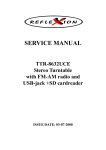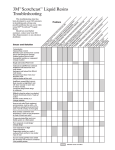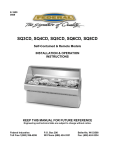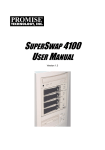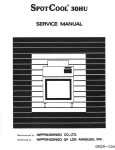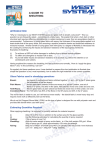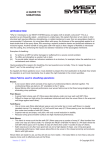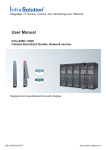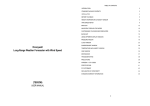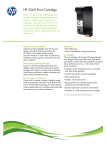Download Spray Elastomer Systems Troubleshooting-WIP
Transcript
Spray Elastomer Systems - TROUBLESHOOTING/APPLICATION PROBLEMS Problem Typical causes Possible solutions Tailing – heavy edge tails at edges of pattern or fingers in the pattern A) Due to material being too viscous. A) Reduce the viscosity of the material by increasing the system heat (primary heater, hose heat, supply temperature). Troubleshoot heating system to insure it is functioning correctly. B) Due to dirty or clogged gun. B) Clean spray gun, mixing chamber or module, and tip. C) Due to poor material atomization C) Increase pressure, and/or increase system heat (primary heaters, hose heat, material temperature), and/or change to a smaller tip and/or mixing chamber or module. Note: test only one change at a time. A) Due to lack of material at spray gun. A) 1) Troubleshoot supply systems. See equipment troubleshooting section. Lack Of Spray Pattern – only a stream of material coming out of tip. 2) Troubleshoot fluid pressure systems to gun. See equipment troubleshooting section. 3) Check and clean fluid filters. Spray Pattern Surging – a pulsating fluid delivery. B) Due to lack of fluid pressure B) Increase pressure and/or increase system and material heat to reduce viscosities. C) Due to worn tip or oversized orifice. C) Replace with new or smaller tip. A) Due to too large a tip orifice. A) Change to a smaller tip. B) Due to insufficient or intermittent air or hydraulic supply to pumps. B) Increase and/or stabilize air/hydraulic supply to pump. C) Due to badly worn packings in pump. C) Replace pump packings. D) Due to cavitation of transfer or proportioning pump. D) 1) Decrease viscosity of material in drums by increasing the temperature. 2) Check for and eliminate any restrictions or clogs in supply system. 3) Check ball and check valves in transfer and proportioning pumps to insure that they are functioning properly. Large Blister(s) (1” to 12”or more) Randomly Occurring Blisters A) Off ratio spurt of coating material, usually different color, which may or may not be subsequently overcoated during the application. This type of blistering may not be immediately apparent. NOTE: If the conditioned occurs and is recognized before overcoating, stop and wipe area with solvent. Allow solvent to flash off and lightly grind area before proceeding, -1- A) Troubleshoot proportioner and gun. B) Poor Mixing or inadequate mixing in mixing chamber. B) To correct do one or more of the following: 1) Reduce viscosity of components by increasing material temperatures and/or the primary heater temperatures. To correct, troubleshoot heaters and hose heat. Check temperature of material at gun. 2) Increase pump pressures, but do not exceed the pressure safety limits of the system. 3) Reduce the size of the fluid chambers, or module (consult your equipment manufacturer or PolySource for details on this change), and reduce orifice size of tip. 4) The “A” and ”B” component were not properly premixed before using, resulting in a stratified individual ingredients of the components being sprayed. To correct, thoroughly and completely power mix (with a mixer such as a ½ to 1 HP mixer .with a folding prop) each individual component so that all material in the drum is moving as a result of the mixing. If only one mixer is used, care must be taken to thoroughly clean off the shaft and blade before transferring from “A” to the “B” container or vice versa, to prevent cross-contamination of the components and a premature chemical reaction. C) The second coat applied prior to the cure of the first coat producing “thermal” blistering. C) Delay the application of the second coat to allow the first coat to cure more thoroughly D) Transfer pumps or proportioning pumps cavitating. D) Troubleshoot transfer pumps and proportioner. Increase material temperature in containers to allow the materials to flow and pump better. It maybe necessary to rebalance discharge of fluids at the gun. E) Solvent blistering as a result of residual solvents in the system. E) Spray out solvent contaminated material prior to starting on project. Insure that any solvent used for cleaning, etc., is fully dried off of substrate prior to application. F) Contamination of substrate with oils, silicone oils, or release agents on surface. F) Eliminate source of contamination. G) Moisture on surface. G) Spray only on absolutely dry surfaces. Preheat substrate to insure dry surfaces. H) Fingering in fan pattern, as a result of poor mixing and independent “A” and “B” streams being sprayed. H) 1) Check heating systems to be sure it is adequately maintaining temperatures. Increase heat at primary heater and in hoses and/or in containers. 2) Increase pressure, but do not exceed safety limitation of system. 3) Decrease tip or mixing chamber or module size. 4) Increase and match mixing chamber or module size and tip size. 5) Do all of the above, one at a time. -2- Regularly Occurring Blisters At Or Near Lap Areas A) Off ration or poor mixed spurt of coating material, may be a different color or texture. Probable cause is trigger or valving rod out of adjustment with the situation being aggravated by excessive triggering at the end of each pass. A) Adjust trigger pull or valving rod to eliminate spurt, or change application technique to eliminate triggering. Small Blisters (generally smaller than 1”) A) Thermal blistering as a function of material temperature. A) Lower hose temperatures, then if still present, reduce pre-heater temperatures. If still present, increase pass speed to decrease the amount of material applied in one pass, or reduce tip size to reduce amount of material applied and the exotherm of the material. B) Thermal blistering as a function of recoat time. B) Allow exotherm heat from initial pass or coat to cool or dissipate before recoating. C) Moisture associated with application: 1) Humidity too high. C) To correct: 1) Discontinue spraying until relative/humidity is below 85% during application of materials. 2) Moisture or water contamination of material 2) Change to different (new) unopened “A” and “B” component. Flush or purge system at gun to insure new material is in system. Dispose of contaminated material. 3) Wet substrate. 3) Spray only on a substrate that is free of dew or residual moisture. D) Solvent blistering as a result solvents used for gun purge mixing with coating, or if solvent flush system is used, mixing as a result of inadequate purge, or solvent being sprayed on surface, then overcoated. D) Properly purge and clean system of all solvent before spraying coatings onto surface. Replace seal or valve on solvent purge if leaking. E) Macro Blistering or Foaming 1) Air entrapment in components as a result of mixing the container. E) 1) Mix material so as not to chum or entrap air in materials. 2) Air entrapment during spray application. 2) Increase spray pressure to increase atomization, but do not exceed the pressure safety limits of the system. Reduce the size of the fluid mixing chamber (consult your equipment manufacturer or PolySource for details on this change). 3) Moisture on substrate on contaminating materials. This reaction causes a foaming or very cellular materials. 3) Eliminate moisture from the substrate. 4) Too much material applied at once or too quickly. 4) Reduce the amount of material applied in one pass or increase the time between passes to allow exotherm to dissipate. F) Surface contamination of substrate with oils, silicone or release agents. -3- F) Eliminate source or contamination. Dull Gloss Material Soft And Glummy Or Tacky After Adequate Cure Time A) Off ratio or poorly mixed material, normally excessive “B” side, but may be “A” side also, may also show slow cure and poor film properties. A) Check pump discharge pressures while pump is cycling. Troubleshoot equipment. B) Temperature too high B) Decrease hose temperatures; If problem persists, then reduce pre-heater temperatures. C) Peak exotherm too high C) Apply last passes thinner and allow some of the exotherm to dissipate before applying additional materials to achieve final millage. A) Inadequate mixing or Impingement mixing atomization too coarse. A) 1) Increase system heat to lower viscosity of materials. (Primary heaters, hose heat, material temperature). 2) Increase pump pressure to increase atomization, but do not exceed the system safety pressure. 3) Reduce the size of the fluid chambers, module, and/or spray tip orifice (consult you equipment manufacturer or Poly-Source for details on this change). 4) Reduce tip size to increase back pressure. 5) Clean and inspect static mixer. 6) Do all of the above, one at a time. B) Materials sprayed Off-ratio as a result of: 1) “A” component or “B” component too cold to pump, producing cavitation of transfer pumps or proportioner pump. B) 1) Pre-condition material at higher ambient temperatures or for longer periods of time to insure the material is at proper pre-spray temperatures. 2) Pre-heater and/or line heaters not set high enough to permit balanced fluid flow to gun. (This may also be evidenced as unbalanced pump pressure.) 2) Increase line temperature and/or pre-heater temperatures. Troubleshoot heating systems. 3) Restrictions in fluid system. 3) Check for restrictions or obstructions in system. May occur as a result of clogged filters, stuck ballcheck valves in pumps, or partially clogged hoses. NOTE: Restriction may be evidenced as imbalanced pump pressures. C) Moisture associated with cure such as fog or dew settling on surface. C) Complete spraying earlier in day to permit a more complete cure, before exposing to high moisture. D) Moisture on surface at time of application. D) Spray only on very dry substrates. -4- Mottled Surface Gloss, Gloss To High, Surface Tacky A) Off-ration coating Isocyante (A) rich. 1) “B” Component too cold to pump, producing cavitation of transfer pump on “B” component side of the proportioner. 2) Obstruction in “B” side fluid path. This condition will usually result in imbalanced pressures and will be reflected on gauges. B) Improper or inadequate mixing. A) 1) Pre-condition the material at higher ambient temperatures, or for longer periods of time. To insure the material is at proper pre-spray temperatures. 2) Eliminated obstruction. B) 1) Check hose temperatures, pre-heater temperatures, and adjust upward, if necessary. 2) Check discharge pressures. Troubleshoot equipment. 3) Check for proper size mixing chamber in gun. Streaks of Color C) Over spray as a result of spraying during conditions of excessive wind. C) Use wide spray fan pattern and work close to surface with maximum size orifice, or delay painting until wind velocity subsides. D) Over spray as a result of arching or flicking the gun at the end of a spray pass. D) Modify spray technique. A) Off ratio or poorly mixed coating as a result of: 1) Unbalanced pump discharge pressures. 2) Material too cold to pump, producing cavitation of transfer pump(s) or proportioning pumps. B) Materials not mixed properly prior to using, permitting settled materials and pigments to enter the spray system as individual ingredients. Foaming of Coating or Micro cellular Structure A) As a result of excessive temperature: 1) Excessive fluid system temperatures. A) 1) Troubleshoot equipment, check and balance discharge pressures. 2) Pre-condition material at higher ambient temperatures for a longer period of time, to insure material is at proper pre-spray temperature. B) Thoroughly mix all materials before using. All materials in the drum or container must be moving to insure complete dispersion of all ingredients. 1) Check and reduce hose temperatures, then primary heater temperatures. 2) Excessive material exotherm temperatures 2) Delay application of additional pass to allow exotherm temperatures from prior pass to dissipate. 3) Excessive substrate temperatures. 3) Cool substrate or place object being sprayed in shade to reduce solar energy pick-up. -5- B) As a result of moisture associated with the application. 1) Relative himidity too high B) 1) Delay application until RH is lower or below 85% 2) Moisture on substrate. 2) Delay application until substrate is dry. 3) Moisture contamination in material. 3) Keep material containers sealed until needed, and after opening, apply a nitrogen blanket to container to prevent moisture from reaching the hydroscopic materials C) Too small a tip size and/or a very high degree of atomization. C) 1) Increase tip orifice size. 2) Lower pressure. Sagging And Running Of Material Pinholeing In Coating Material Fish Eyes in Coating 1) Material temperature too low. 1) Increase fluid system temperatures so materials will set faster. 2) Excessive coating thickness 2) Apply less material by using either a smaller tip or increasing speed of each pass. 3) Off ratio coating 3) Troubleshoot equipment. A) Pinholes exist in the substrate. A) Eliminate pinholes in the substrate. B) Moisture contamination of the material. B) Keep material containers sealed until needed. After opening, apply nitrogen blanket to container to prevent moisture from reaching the hydroscopic materials. C) Moisture contamination on substrate. C) Allow substrate to dry thoroughly before applying coating. D) Excessive heat. D) Reduce hose and primary heaters. E) Over atomization of material. E) Decrease tip size and/or lower pressure A) Surface contamination associated with oils, substrate oils, or release agents on surface. A) Eliminate source of combination B) Material not wetting out and covering the surface. B) Increase material temperatures to reduce viscosities. Decrease substrate temperature. Increase temperature and pressure to increase atomization. Apply material in thicker pass. ____________________________________________________________________________________ #1 - 19725 Telegraph Trail, Langley, BC V1M 3E6 Tel: (604) 888-3505 Fax: (604) 888-3503 -6-






